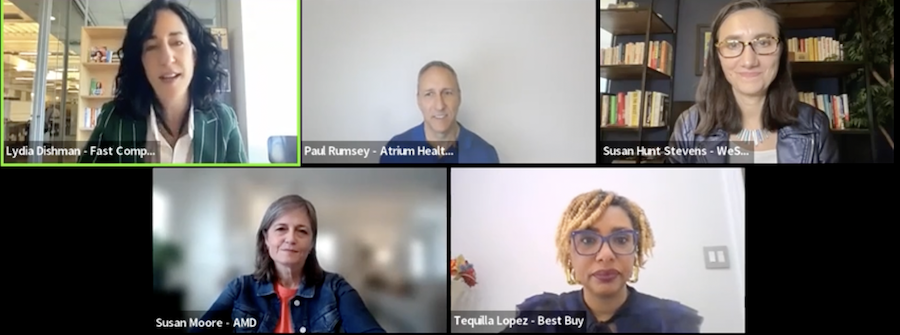Making Work Meaningful in an Era of Rapid Change


Paul Rumsey, senior vice president of strategic operation of Atrium Health, believes that purpose starts in small actions. He has urged his employees to block calendars until 9am on Monday mornings and after 2pm on Fridays. Likewise, emails should not be sent in the evenings or on weekends unless the matter is absolutely urgent. Meetings are to be cut from 60 to 45 minutes, or from 30 to 25 minutes.
Also, as he revealed to journalist Lydia Dishman in a panel at From Day One’s March 2023 virtual conference, a defining characteristic of Atrium Health is its usage of “Code Lavender.” First developed in the Cleveland Clinic, this initiative is meant to take care of the secondary victim: for example, a nurse who needs to cultivate calm after a stressful situation, such as a difficult diagnosis or the loss of a patient.
All of these implementations undergird the purpose of the organization: Hope, Health, and Healing for All.
In fact, while a sense of stability might be hard to come by in the work world, a sense of meaning can be both durable and attainable. In 2021, McKinsey surveyed more than 1,200 managers and frontline employees, revealing an overwhelming consensus on the importance of purpose at work: 72% of respondents maintained that purpose should come before profits. Only 42%, however, felt that their company’s stated purpose made a real difference. A major source of this problem are overly generic mission statements like “contributing to society” and “creating meaningful work.”
Leaders can examine their own experiences to discover what’s genuinely inspirational and motivating. “I want to be able to look my kids in the eyes,” said Susan Hunt Stevens, chief executive officer of the ESG engagement software company WeSpire, referring to the climate crisis and how it will unfold in the next decades. Tequilla Lopez, who leads the social impact team at consumer electronics retailer Best Buy, has drawn on her extensive nonprofit background to help shape the company’s sense of purpose. “It’s easy for our team,” she explains to Dishman. “Everything we do has a tie to our youth population: ensuring they have access and exposure in a way they wouldn’t ordinarily have.”
Identifying the Why
Identifying the “why” behind a company goes hand-in-hand with addressing business concerns. “Everything we do, I make sure it’s advancing the business,” said Susan Moore, vice president of corporate responsibility for semiconductor company AMD. “If we get untethered from where the business is going, whatever we’re doing may not be sustainable.”

In the case of Atrium Health, an initiative called “Voice of the Team” helps keep track of what’s important to people in the organization. “We do work anniversary surveys; we ask what people are doing, what’s important to them, and we come up with solutions to really address that,” said Rumsey. Lopez also stressed the importance of “speaking from a place of knowledge, not just theory.”
Hunt Stevens added a major caveat: “One thing we have to think about,” she said, “is whether the company itself has made purpose a core of its strategy or if it’s just a pair of Mickey Mouse ears.”
Between Burnout and Purpose: The Role of Balance
We can’t talk about purpose without considering the looming risk of burnout. The more an organization wants to accomplish, the more eagerness employees will feel to undertake purpose-driven actions. But to what extent?
“It’s a process,” said Lopez, whose reports are often tasked with a lot of travel. “It’s my goal to avoid burnout for employees, so I’ll be the bad guy and tell them no. And honestly, over the last year, we completely revamped the ways in which we engage to make sure there’s enough time to get your desk work done and then be present when on the road.”
Hunt Stevens relies on a tool developed by HBS to measure psychological safety, since the highest levels of psychological safety correspond to the highest levels of performance. “We’ve all been in organizations where, even if we’re only working a shift, it’s painful,” she reasoned. “Then we’ve worked in places where going overtime is a flow. It comes down to psychological safety and how safe we feel in groups and on teams. We will see people feel much better about work and life integration.”
(Big) Little Acts of Recognition
Even the most altruistic person needs a pat on the back for a job well done. To Hunt Stevens, recognition and morale boosting start with belonging. “One of the most powerful things I’ve seen are affinity groups,” she said. “ERGs are a mechanism for test-driving leadership, activating belonging, and recognizing people to galvanize impact.”
Hunt Stevens also points to an initiative by fellow panelist Moore. During a recent SXSW festival, AMD sponsored an event where attendees volunteered to clean up a river. “We volunteered together at an industry event: this is how I think leaders can start thinking really creatively,” Hunt Stevens. Moore, on her end, has one crucial piece of advice, which can be career-defining for junior-level employees but isn’t labor-intensive: “At the end of emails, acknowledge person X, Y, Z for their contributions,” she said. “It recognizes a great team and helps people understand what their contributions ended up achieving.”
Angelica Frey is a writer and a translator based in Boston and Milan.
The From Day One Newsletter is a monthly roundup of articles, features, and editorials on innovative ways for companies to forge stronger relationships with their employees, customers, and communities.